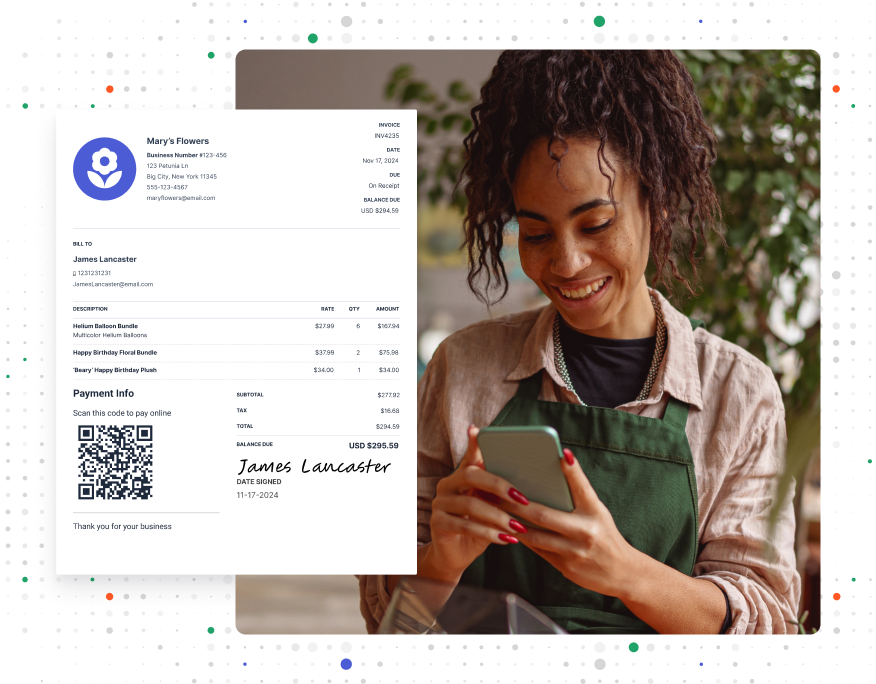What Is a Good Profit Margin For a Small Business?

In the business world, money talks. But what’s it telling you?
To hear the true story of your business’s performance, you need to understand the language of profit margins. Profit margins are like scorecards for businesses. It shows how much money is left from your sales after expenses. And while some types of businesses have higher average profit margins, it all depends on the type of business and how well it’s run.
In this article, we’ll answer the question “What is a good profit margin?” and explain why it matters. You’ll learn what small businesses should know about these values, plus discover some helpful tips to boost your own profit margin.
RELATED RESOURCE — Free Profit Margin Calculator & How-to Guide
Profit Margins 101
Profit margins are a way to measure how much money your business keeps from its sales after paying all its expenses. They’re evidence of how good you are at turning your hard work into actual profits.
A profit margin is expressed as a percentage, which makes it easy to compare different businesses and track progress over time. You can calculate it with this formula:
Profit margin = (Net profit / Total revenue) x 100
To calculate profits, subtract your expenses from your sales:
Net profit = Sales – Expenses
Here’s a simple example to illustrate how profit margins work. Suppose you sell lemonade for $1 a cup and it costs you 60 cents to make each cup (including the cost of lemons, sugar, and cups):
Net profit = $1.00 – $0.60
To then calculate the profit margin, divide that 40 cents by the selling price of $1 and multiply by 100:
Profit margin = ($0.40 / $1.00) x 100 = 40
That gives us a 40% profit margin.
What Is a Good Profit Margin?
Now that you understand the basics of profit margins, it’s natural to wonder: What is a good profit margin ratio, exactly? And what is a good profit margin for a small business, specifically? The answer isn’t as simple as you might hope. A good profit margin can vary widely depending on several factors.
What’s good in one industry might be not-so-good in another. It can also change based on where your business is located.
For example, a jewelry store might have a higher profit margin than a grocery store. Why is that? It’s because jewelry stores sell expensive items less often, while grocery stores sell lots of cheaper items all the time. This means that while they might sell fewer items, each sale brings in a bigger profit. So, when comparing profit margins, it makes the most sense to look at businesses in the same industry.
But when looking at your industry, you should consider similar businesses. A city restaurant might need a higher profit margin than one in a small town due to higher rent. Other factors include business size, how long you’ve been operating, current economic conditions, and even the time of year if your business is seasonal.
Ultimately, a good profit margin is one that allows your business to thrive and grow. This means covering all costs, paying sustainable wages, and having enough left to reinvest or save for tough times.
RELATED ARTICLE — The Top Financial KPIs To Monitor for Your Business
There are also different types of profit margins. When most people talk about profit margin, they’re referring to net profit margin, also referred to simply as net margin. This is the most comprehensive type of profit margin because it takes everything into account. That includes all your sales, as well as costs, taxes, interest, and any other expenses. It’s the clearest picture of how much money your business is really making.
To calculate your net margin, use the formula from the example above.
Who Uses Profit Margins?
The short answer is: Just about everyone in the business world. Here are some examples:
- Business Owners. They use profit margins to examine their company’s financial health. It helps them make important decisions, like whether they need to raise prices or find ways to cut costs.
- Investors. Someone buying into a company would look at profit margins. A good profit margin usually means a company is doing well and may be a smart investment.
- Managers. Profit margins can be a metric that help businesses set goals and measure performance. There might be a target profit margin a company wants to reach.
- Lenders. Profit margins are used by lenders to decide whether to give a business a loan. A healthy profit margin suggests the business will be able to pay it back on time.
Keep in mind that while a higher profit margin is usually better, it’s not the only metric that matters. Sometimes, a business might choose to have a lower profit margin to gain more customers or grow faster. It’s all about finding the right balance for your specific business and goals.
Other Types of Profit Margins

Here are some of the other common types of profit margins.
Gross Profit Margin
This margin looks at how much money you’re making from your products before you factor in other costs. It doesn’t include other business expenses like rent or salaries.
You calculate it by subtracting the cost of goods sold from your total revenue, then dividing by total revenue and multiplying by 100. It’s useful for seeing how efficiently you’re producing or selling your products.
FROM ONE OF OUR PARTNERS — How To Calculate Gross Profit Margin
Operating Profit Margin
This margin goes a step further than a gross profit margin. It includes the costs of running your business day-to-day, like rent and employee salaries, but it doesn’t include taxes or interest payments. It’s a good way to see how well you’re managing your operating expenses.
Pre-tax Profit Margin
As the name suggests, this margin includes everything except taxes. It’s helpful for comparing businesses that have different tax profiles.
Profit Margin Benchmarks for Small Businesses
Since good profit margins vary widely by industry, it’s crucial to research benchmarks specific to your field. Let’s look at some typical profit margins for different small business industries:
- Apparel: 3.15%
- Business & Consumer Services: 5.45%
- Food Processing: 6.00%
- Healthcare Support Services: 2.25%
- Publishing & Newspapers: 1.82%
- Recreation: 0.90%
- Restaurant/Dining: 10.66%
- Retail (Automotive): 4.32%
- Retail (Grocery and Food): 1.18%
- Retail (Special Lines): 1.45%
As we can see, profit margins vary significantly. On this list, Restaurant/Dining has the highest average at 10.66%, while Recreation has the lowest at 0.90%. Retail businesses tend to have lower margins due to factors like strong competition and the need to keep prices low.
Remember that not every business adheres closely to these numbers. Some businesses in each industry will do better, others worse. Your profit margin depends on how well you manage costs, price your products or services, and provide value to customers.
FROM ONE OF OUR PARTNERS — Overhead Costs: Examples, Definition, and Types
Tips for Improving Your Profit Margin

Let’s take a look at some ways to improve your own profit margin. These tips can help you keep more of the money you earn, no matter what kind of business you run:
- Reduce Costs. Look for ways to cut expenses without sacrificing quality. This could mean finding cheaper suppliers or cutting back on unnecessary spending.
- Adjust Your Pricing Strategy. Sometimes, raising your prices just a little bit can make a big difference in your profit margin. Just make sure your customers still feel they’re getting good value for money.
- Improve Operational Efficiency. Find ways to get your core operations done faster or with less waste. This could mean using better tools or training your team to work more efficiently.
- Negotiate Terms With Suppliers. Try to get better deals on the items you buy for your business. This could mean lower prices, better payment terms, or even higher-quality goods for the same price.
RELATED ARTICLE — How To Calculate Cash Flow: Key Formulas and Practical Examples
Business Expense Tracker
You can’t track your profit margin if you don’t know how much you’re spending on expenses.
expense trackerTracking expenses has never been easier. Our business expense and receipt tracker lets you scan any receipt, and we capture key info automatically. All your expense data is ready to export into a summary report whenever you need it.
Start Your First
Invoice Today
Create customized and professional
invoices and connect with clients
